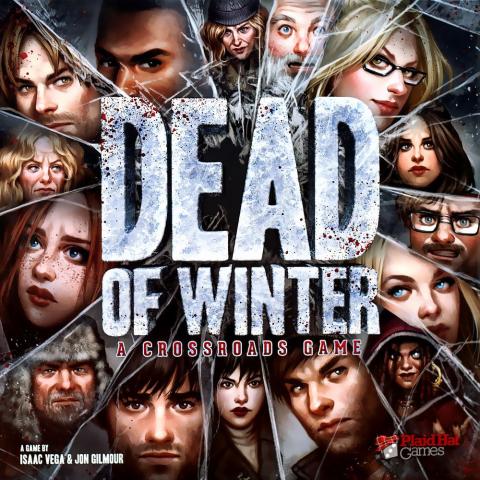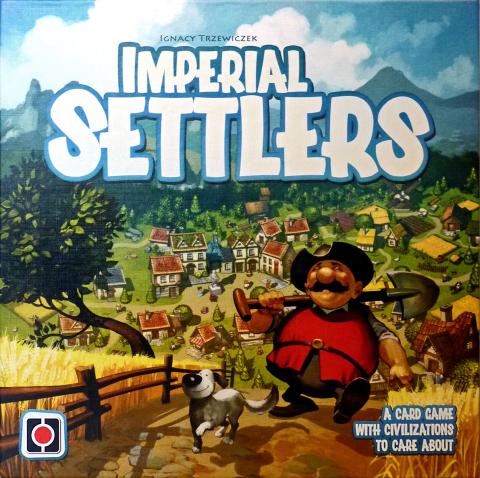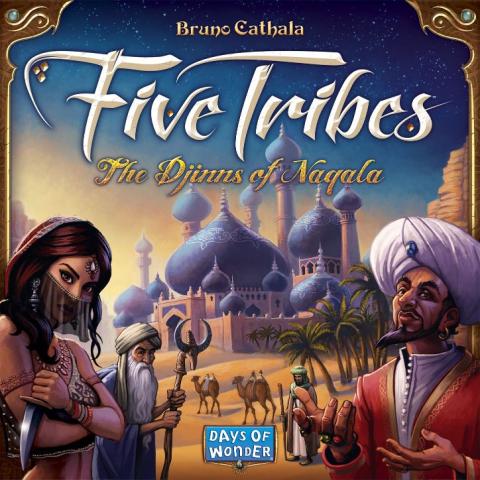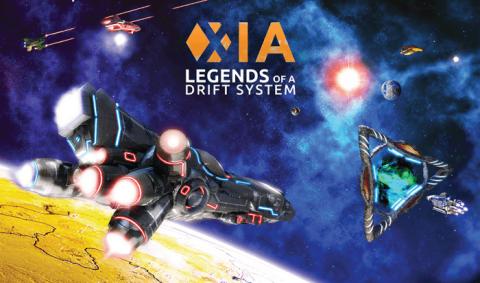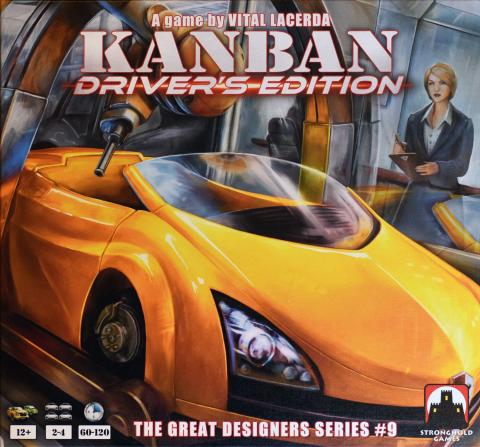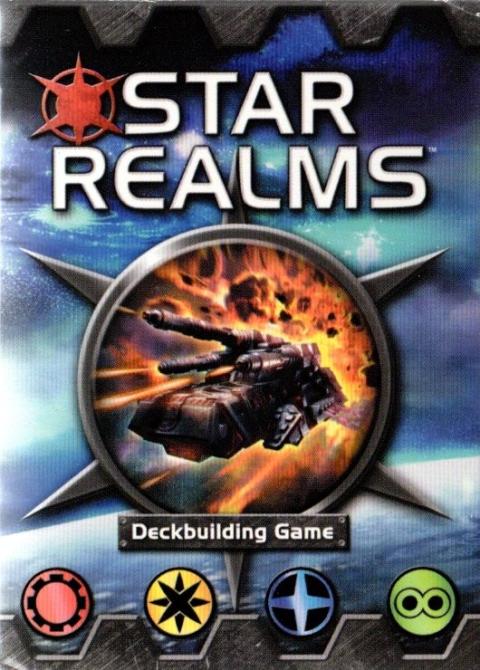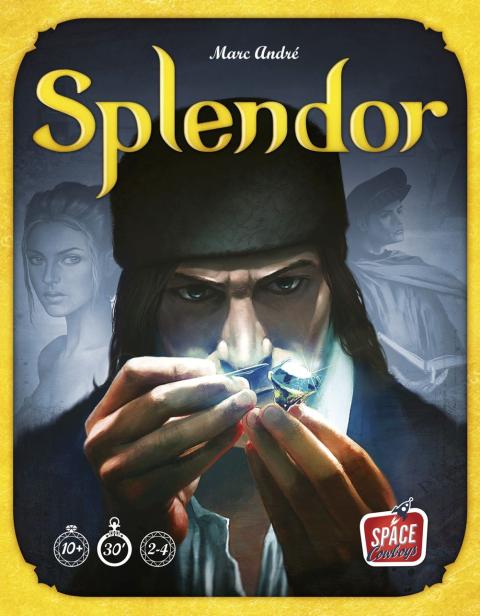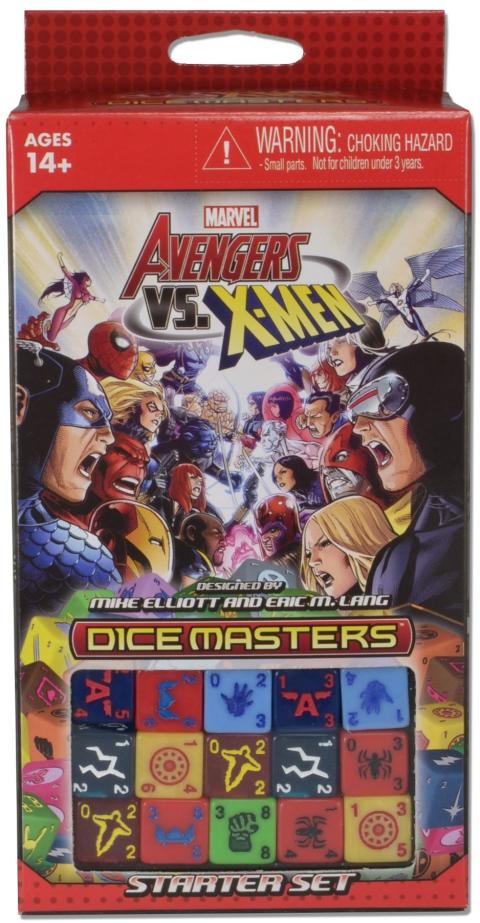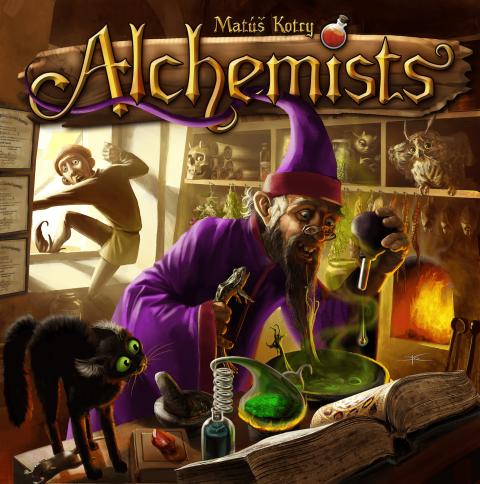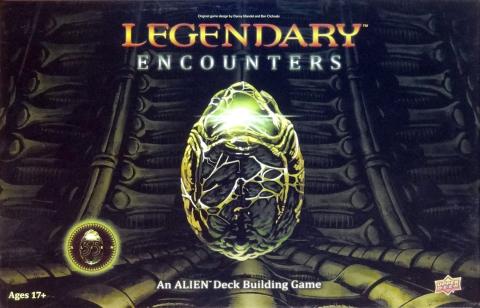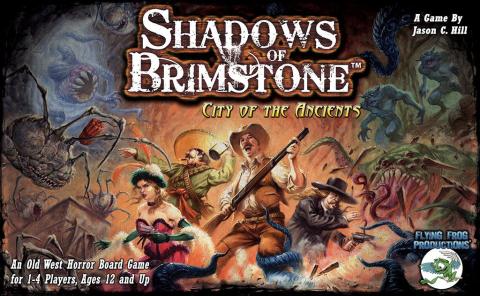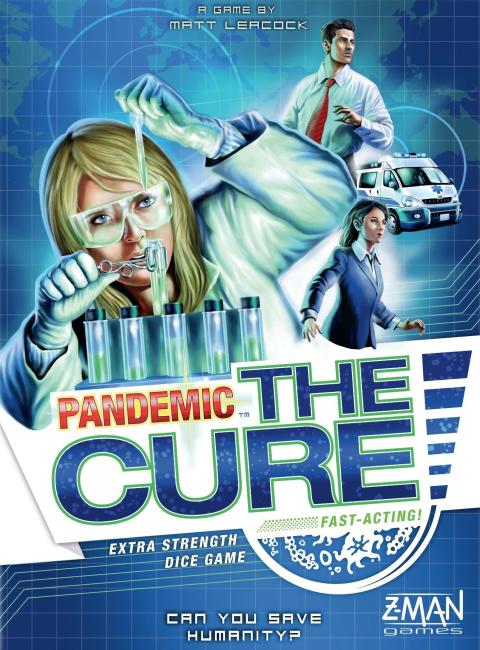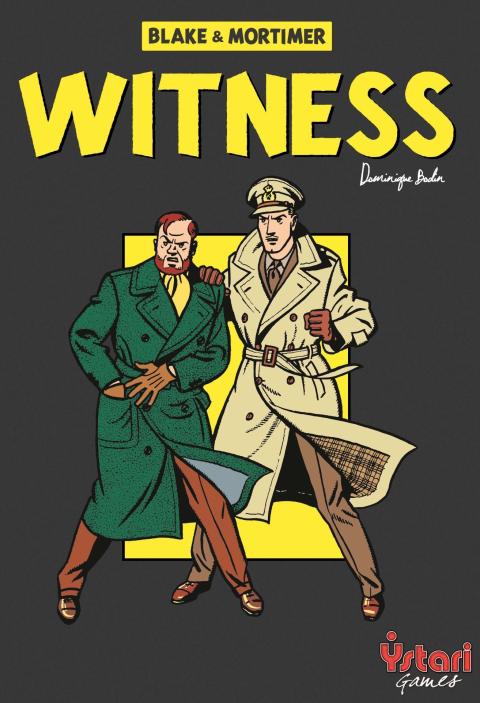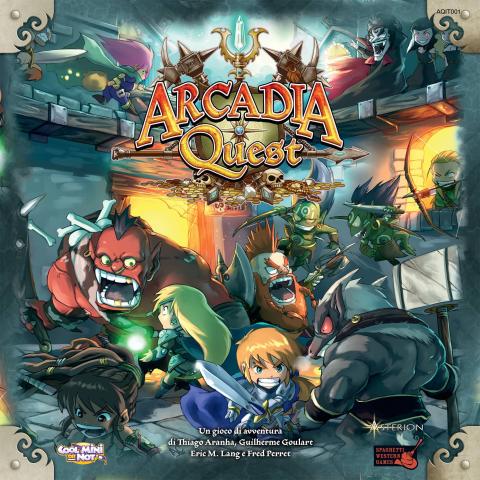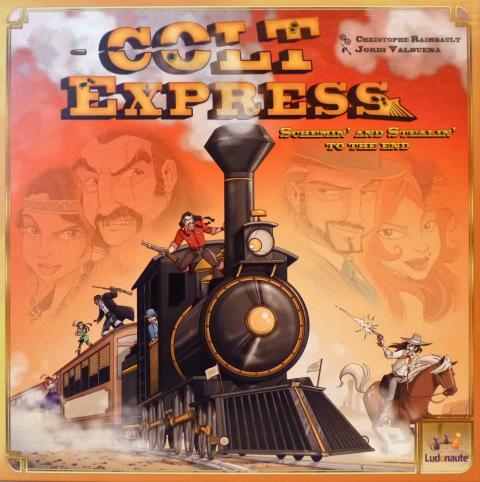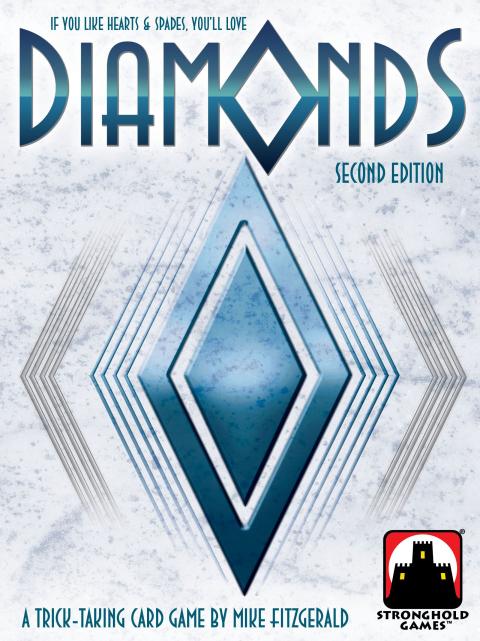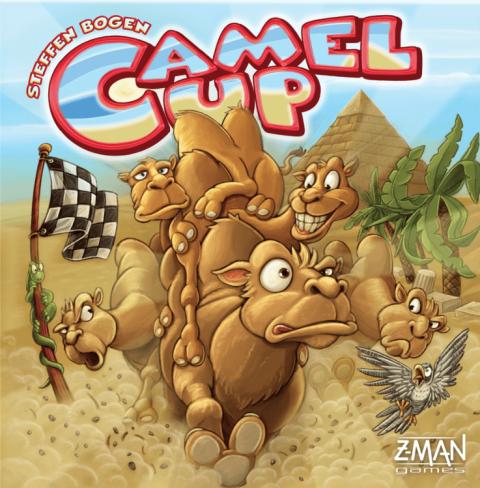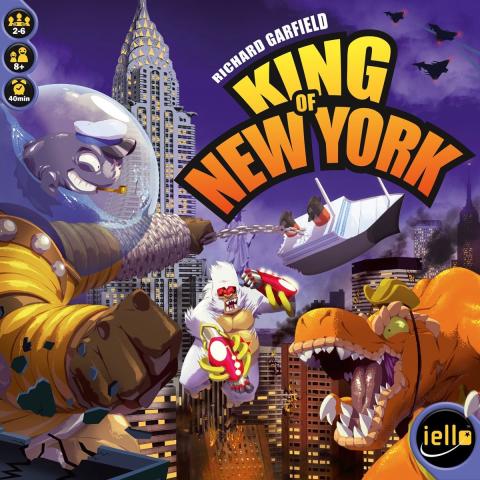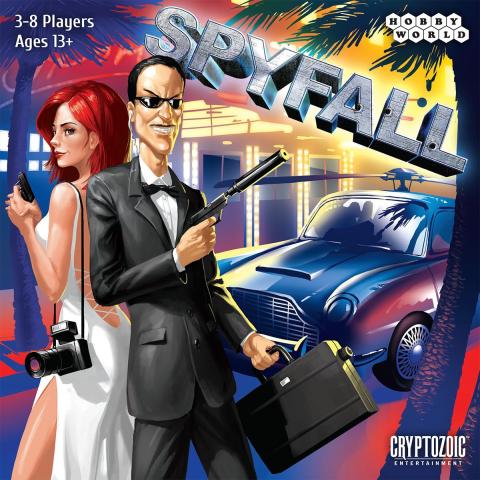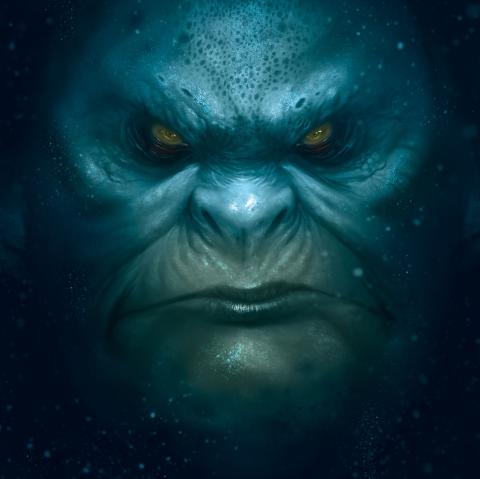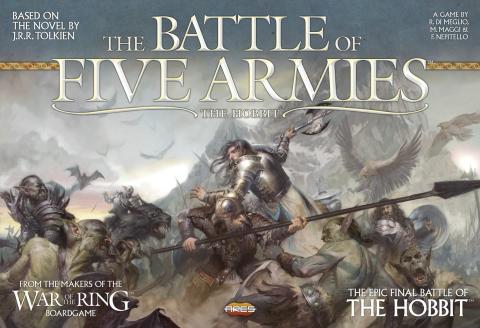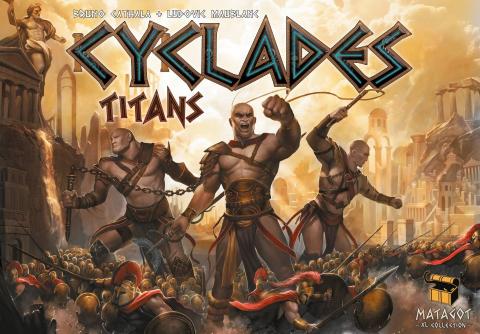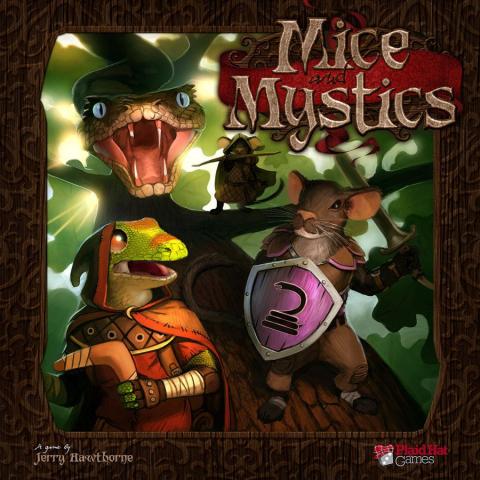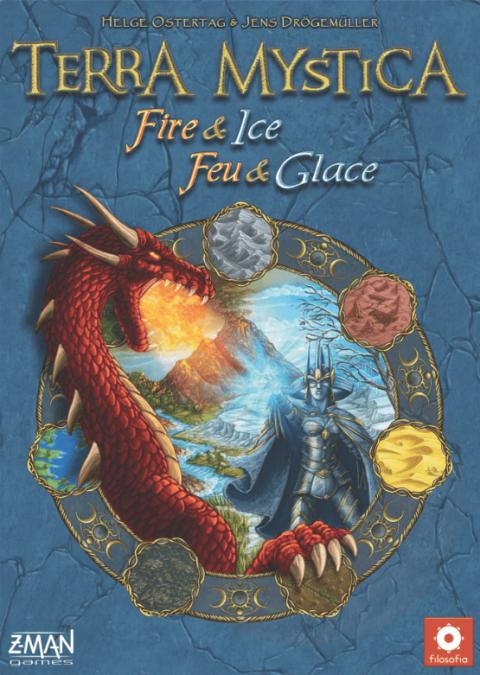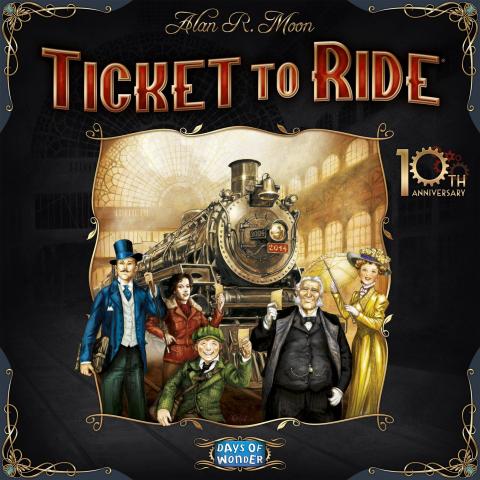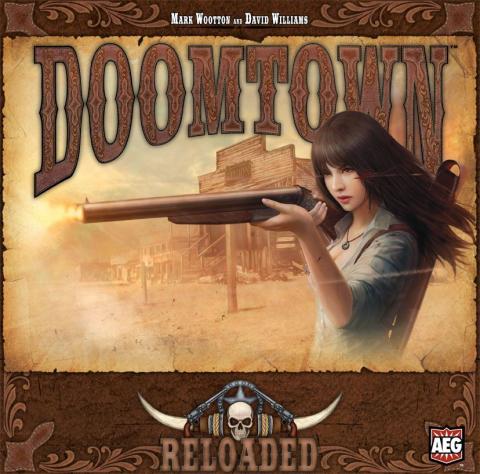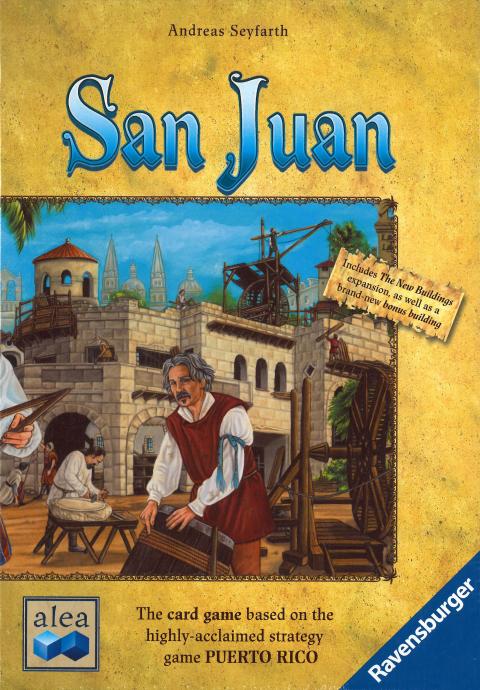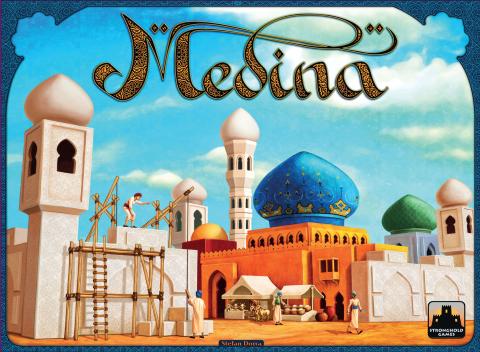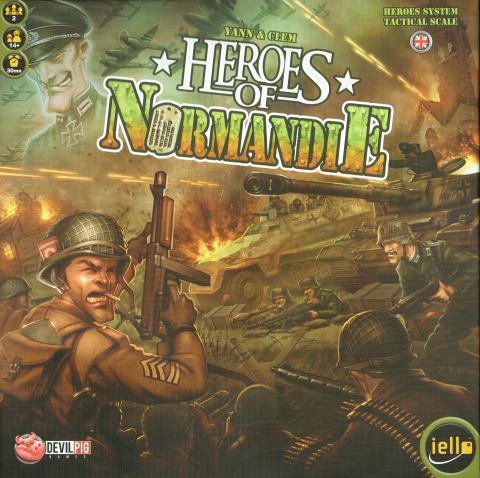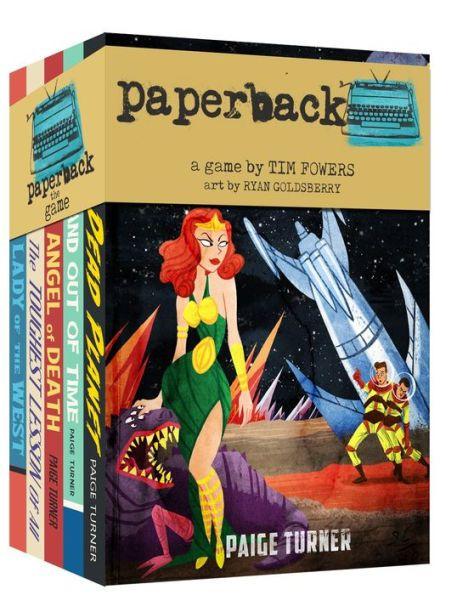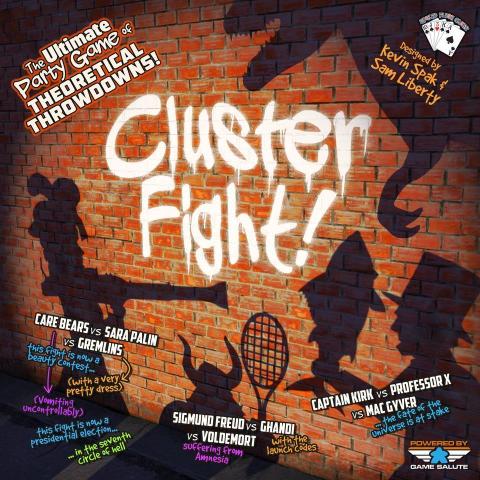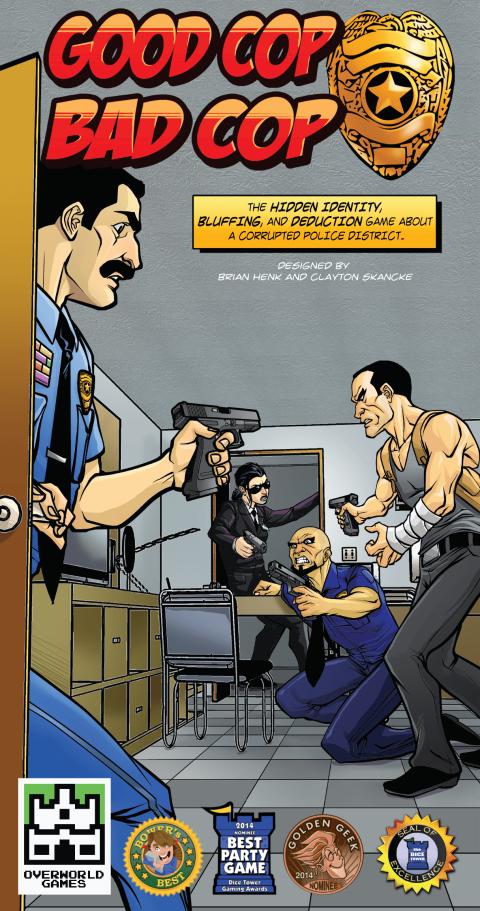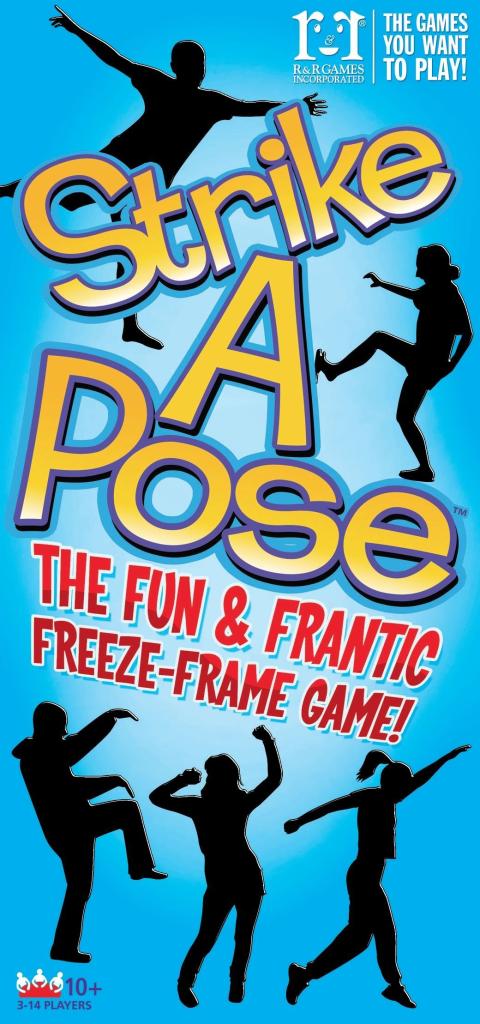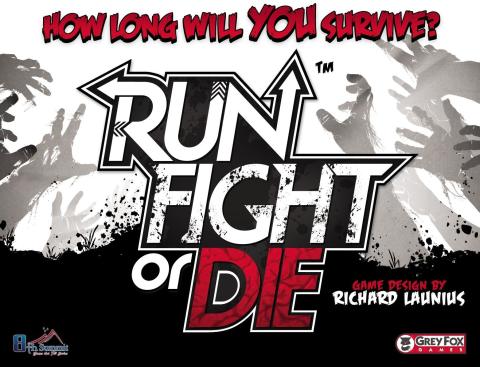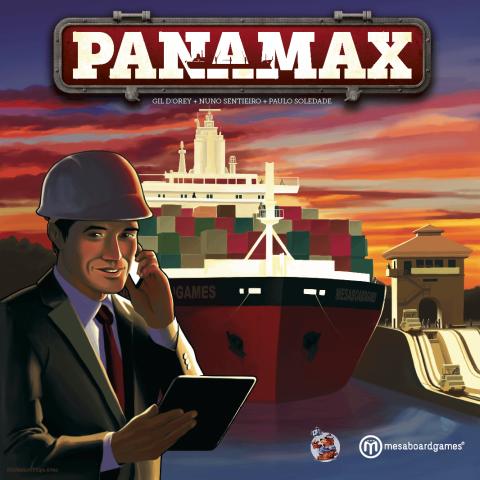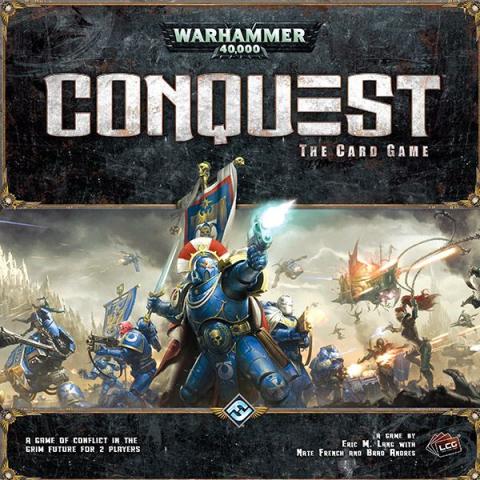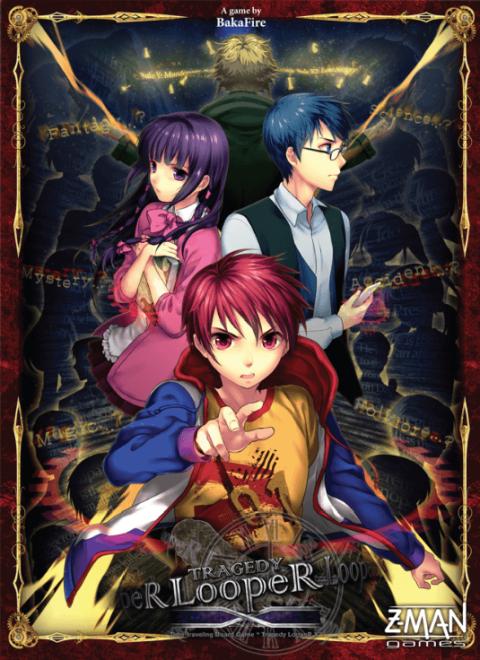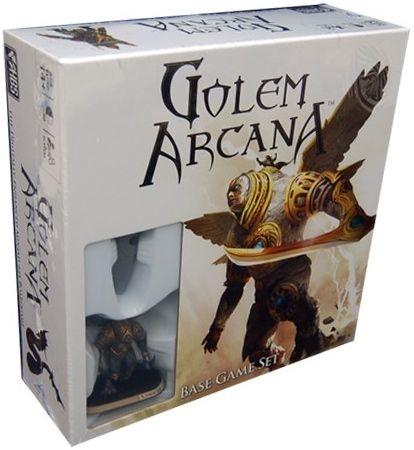Presenting the nominees of the eight annual Dice Tower Awards for games released in 2014 in categories including artwork, small publisher, new designer, and the game of the year!
Game of the Year
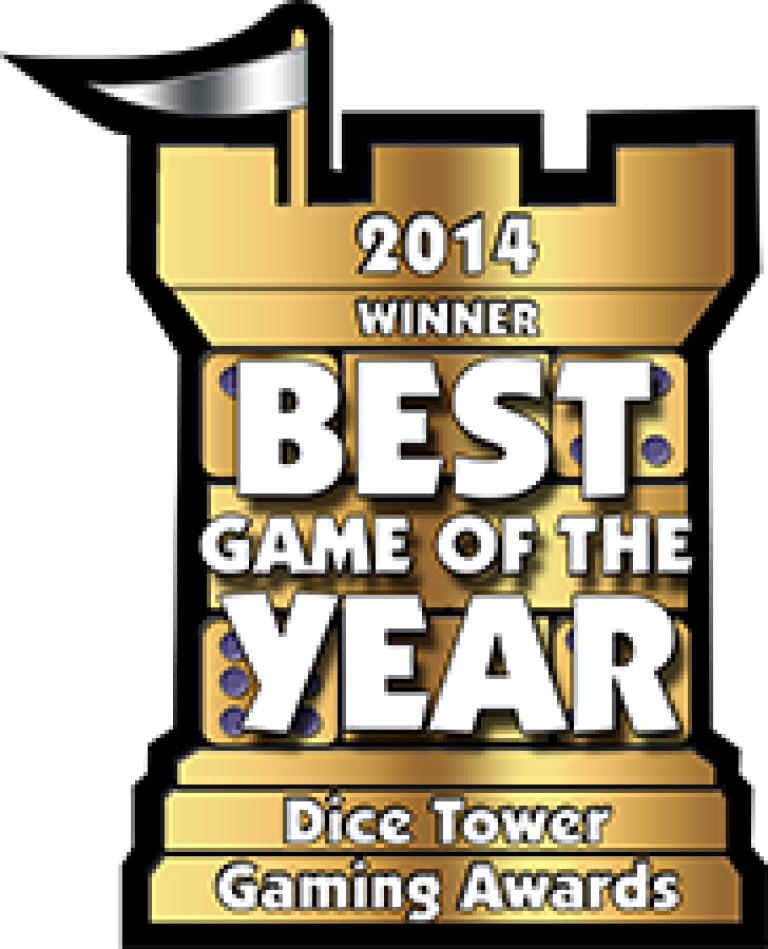
"Crossroads" is a game series from Plaid Hat Games that tests a group of survivors' ability to work together and stay alive while facing crises and challenges from both outside and inside. Dead of Winter: A Crossroads Game, the first title in this series, puts 2-5 players in a small, weakened colony of survivors in a world in which most of humanity is either dead or diseased, flesh-craving monsters. Each player leads a faction of survivors, with dozens of different characters in the game.
Dead of Winter is a meta-cooperative psychological survival game. This means players are working together toward one common victory condition, but for each individual player to achieve victory, they must also complete their personal secret objective, which could relate to a psychological tick that's fairly harmless to most others in the colony, a dangerous obsession that could put the main objective at risk, a desire for sabotage of the main mission, or (worst of all) vengeance against the colony! Games could end with all players winning, some winning and some losing, or all players losing. Work toward the group's goal, but don't get walked all over by a loudmouth who's looking out only for their own interests!
Dead of Winter is an experience that can be accomplished only through the medium of tabletop games, a story-centric game about surviving through a harsh winter in an apocalyptic world. The survivors are all dealing with their own psychological imperatives, but must still find a way to work together to fight off outside threats, resolve crises, find food and supplies, and keep the colony's morale up.
Dead of Winter has players making frequent, difficult, heavily-thematic, wildly-varying decisions that often have them deciding between what's best for the colony and what's best for themselves. The rulebook also includes a fully co-operative variant in which all players work toward the group objective with no personal goals.
Dead of Winter is a meta-cooperative psychological survival game. This means players are working together toward one common victory condition, but for each individual player to achieve victory, they must also complete their personal secret objective, which could relate to a psychological tick that's fairly harmless to most others in the colony, a dangerous obsession that could put the main objective at risk, a desire for sabotage of the main mission, or (worst of all) vengeance against the colony! Games could end with all players winning, some winning and some losing, or all players losing. Work toward the group's goal, but don't get walked all over by a loudmouth who's looking out only for their own interests!
Dead of Winter is an experience that can be accomplished only through the medium of tabletop games, a story-centric game about surviving through a harsh winter in an apocalyptic world. The survivors are all dealing with their own psychological imperatives, but must still find a way to work together to fight off outside threats, resolve crises, find food and supplies, and keep the colony's morale up.
Dead of Winter has players making frequent, difficult, heavily-thematic, wildly-varying decisions that often have them deciding between what's best for the colony and what's best for themselves. The rulebook also includes a fully co-operative variant in which all players work toward the group objective with no personal goals.
Year Published:
2014
Designers:
Jonathan Gilmour
Publishers:
Plaid Hat Games

Best Co-op Game
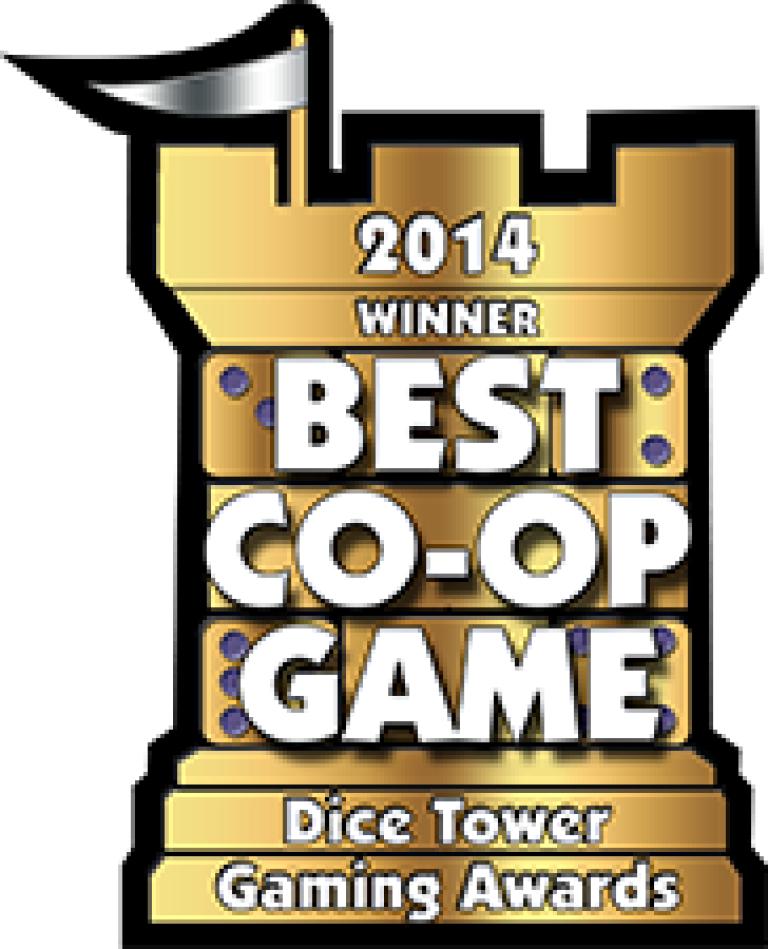
"Crossroads" is a game series from Plaid Hat Games that tests a group of survivors' ability to work together and stay alive while facing crises and challenges from both outside and inside. Dead of Winter: A Crossroads Game, the first title in this series, puts 2-5 players in a small, weakened colony of survivors in a world in which most of humanity is either dead or diseased, flesh-craving monsters. Each player leads a faction of survivors, with dozens of different characters in the game.
Dead of Winter is a meta-cooperative psychological survival game. This means players are working together toward one common victory condition, but for each individual player to achieve victory, they must also complete their personal secret objective, which could relate to a psychological tick that's fairly harmless to most others in the colony, a dangerous obsession that could put the main objective at risk, a desire for sabotage of the main mission, or (worst of all) vengeance against the colony! Games could end with all players winning, some winning and some losing, or all players losing. Work toward the group's goal, but don't get walked all over by a loudmouth who's looking out only for their own interests!
Dead of Winter is an experience that can be accomplished only through the medium of tabletop games, a story-centric game about surviving through a harsh winter in an apocalyptic world. The survivors are all dealing with their own psychological imperatives, but must still find a way to work together to fight off outside threats, resolve crises, find food and supplies, and keep the colony's morale up.
Dead of Winter has players making frequent, difficult, heavily-thematic, wildly-varying decisions that often have them deciding between what's best for the colony and what's best for themselves. The rulebook also includes a fully co-operative variant in which all players work toward the group objective with no personal goals.
Dead of Winter is a meta-cooperative psychological survival game. This means players are working together toward one common victory condition, but for each individual player to achieve victory, they must also complete their personal secret objective, which could relate to a psychological tick that's fairly harmless to most others in the colony, a dangerous obsession that could put the main objective at risk, a desire for sabotage of the main mission, or (worst of all) vengeance against the colony! Games could end with all players winning, some winning and some losing, or all players losing. Work toward the group's goal, but don't get walked all over by a loudmouth who's looking out only for their own interests!
Dead of Winter is an experience that can be accomplished only through the medium of tabletop games, a story-centric game about surviving through a harsh winter in an apocalyptic world. The survivors are all dealing with their own psychological imperatives, but must still find a way to work together to fight off outside threats, resolve crises, find food and supplies, and keep the colony's morale up.
Dead of Winter has players making frequent, difficult, heavily-thematic, wildly-varying decisions that often have them deciding between what's best for the colony and what's best for themselves. The rulebook also includes a fully co-operative variant in which all players work toward the group objective with no personal goals.
Year Published:
2014
Designers:
Jonathan Gilmour
Publishers:
Plaid Hat Games

Best Board Game Components

Star Wars: Imperial Assault is a strategy board game of tactical combat and missions for two to five players, offering two distinct games of battle and adventure in the Star Wars universe!
Imperial Assault puts you in the midst of the Galactic Civil War between the Rebel Alliance and the Galactic Empire after the destruction of the Death Star over Yavin 4. In this game, you and your friends can participate in two separate games. The campaign game pits the limitless troops and resources of the Galactic Empire against a crack team of elite Rebel operatives as they strive to break the Empire’s hold on the galaxy, while the skirmish game invites you and a friend to muster strike teams and battle head-to-head over conflicting objectives.
In the campaign game, Imperial Assault invites you to play through a cinematic tale set in the Star Wars universe. One player commands the seemingly limitless armies of the Galactic Empire, threatening to extinguish the flame of the Rebellion forever. Up to four other players become heroes of the Rebel Alliance, engaging in covert operations to undermine the Empire’s schemes. Over the course of the campaign, both the Imperial player and the Rebel heroes gain new experience and skills, allowing characters to evolve as the story unfolds.
Imperial Assault offers a different game experience in the skirmish game. In skirmish missions, you and a friend compete in head-to-head, tactical combat. You’ll gather your own strike force of Imperials, Rebels, and Mercenaries and build a deck of command cards to gain an unexpected advantage in the heat of battle. Whether you recover lost holocrons or battle to defeat a raiding party, you’ll find danger and tactical choices in every skirmish.
As an additional benefit, the Luke Skywalker Ally Pack and the Darth Vader Villain Pack are included within the Imperial Assault Core Set. These figure packs offer sculpted plastic figures alongside additional campaign and skirmish missions that highlight both Luke Skywalker and Darth Vader within Imperial Assault.
With these Imperial Assault and other Figure Packs, you'll find even more missions that allow your heroes to fight alongside iconic characters from the Star Wars saga. Boxed expansions add more heroes, imperial and mercenary groups, and totally new campaigns (see IA Community Wiki for a list), and the free Star Wars: Imperial Assault – Legends of the Alliance app provides you with additional content to play in solo or co-op mode.
Imperial Assault puts you in the midst of the Galactic Civil War between the Rebel Alliance and the Galactic Empire after the destruction of the Death Star over Yavin 4. In this game, you and your friends can participate in two separate games. The campaign game pits the limitless troops and resources of the Galactic Empire against a crack team of elite Rebel operatives as they strive to break the Empire’s hold on the galaxy, while the skirmish game invites you and a friend to muster strike teams and battle head-to-head over conflicting objectives.
In the campaign game, Imperial Assault invites you to play through a cinematic tale set in the Star Wars universe. One player commands the seemingly limitless armies of the Galactic Empire, threatening to extinguish the flame of the Rebellion forever. Up to four other players become heroes of the Rebel Alliance, engaging in covert operations to undermine the Empire’s schemes. Over the course of the campaign, both the Imperial player and the Rebel heroes gain new experience and skills, allowing characters to evolve as the story unfolds.
Imperial Assault offers a different game experience in the skirmish game. In skirmish missions, you and a friend compete in head-to-head, tactical combat. You’ll gather your own strike force of Imperials, Rebels, and Mercenaries and build a deck of command cards to gain an unexpected advantage in the heat of battle. Whether you recover lost holocrons or battle to defeat a raiding party, you’ll find danger and tactical choices in every skirmish.
As an additional benefit, the Luke Skywalker Ally Pack and the Darth Vader Villain Pack are included within the Imperial Assault Core Set. These figure packs offer sculpted plastic figures alongside additional campaign and skirmish missions that highlight both Luke Skywalker and Darth Vader within Imperial Assault.
With these Imperial Assault and other Figure Packs, you'll find even more missions that allow your heroes to fight alongside iconic characters from the Star Wars saga. Boxed expansions add more heroes, imperial and mercenary groups, and totally new campaigns (see IA Community Wiki for a list), and the free Star Wars: Imperial Assault – Legends of the Alliance app provides you with additional content to play in solo or co-op mode.
Year Published:
2014
Designers:
Justin Kemppainen
Publishers:
Fantasy Flight Games

Best Family Game

Splendor is a game of chip-collecting and card development. Players are merchants of the Renaissance trying to buy gem mines, means of transportation, shops—all in order to acquire the most prestige points. If you're wealthy enough, you might even receive a visit from a noble at some point, which of course will further increase your prestige.
On your turn, you may (1) collect chips (gems), or (2) buy and build a card, or (3) reserve one card. If you collect chips, you take either three different kinds of chips or two chips of the same kind. If you buy a card, you pay its price in chips and add it to your playing area. To reserve a card—in order to make sure you get it, or, why not, your opponents don't get it—you place it in front of you face down for later building; this costs you a round, but you also get gold in the form of a joker chip, which you can use as any gem.
All of the cards you buy increase your wealth as they give you a permanent gem bonus for later buys; some of the cards also give you prestige points. In order to win the game, you must reach 15 prestige points before your opponents do.
On your turn, you may (1) collect chips (gems), or (2) buy and build a card, or (3) reserve one card. If you collect chips, you take either three different kinds of chips or two chips of the same kind. If you buy a card, you pay its price in chips and add it to your playing area. To reserve a card—in order to make sure you get it, or, why not, your opponents don't get it—you place it in front of you face down for later building; this costs you a round, but you also get gold in the form of a joker chip, which you can use as any gem.
All of the cards you buy increase your wealth as they give you a permanent gem bonus for later buys; some of the cards also give you prestige points. In order to win the game, you must reach 15 prestige points before your opponents do.
Year Published:
2014
Designers:
Marc André
Publishers:
Space Cowboys

Best Artwork

The Abyss power is once again vacant, so the time has come to get your hands on the throne and its privileges. Use all of your cunning to win or buy votes in the Council. Recruit the most influential Lords and abuse their powers to take control of the most strategic territories. Finally, impose yourself as the only one able to rule the Abyssal people!
Abyss is a game of development, combination and collection in which players try to take control of strategic locations in an underwater city. To achieve this, players must develop on three levels: first by collecting allies, then using them to recruit Lords of the Abyss, who will then grant access to different parts of the city. Players acquire cards through a draft of sorts, and the Lords of the Abyss acquired on those cards grant special powers to the cardholder — but once you use the cards to acquire a location, that power is shut off, so players need to time their land grabs well in order to put themselves in the best position for when the game ends.
Abyss is a game of development, combination and collection in which players try to take control of strategic locations in an underwater city. To achieve this, players must develop on three levels: first by collecting allies, then using them to recruit Lords of the Abyss, who will then grant access to different parts of the city. Players acquire cards through a draft of sorts, and the Lords of the Abyss acquired on those cards grant special powers to the cardholder — but once you use the cards to acquire a location, that power is shut off, so players need to time their land grabs well in order to put themselves in the best position for when the game ends.
Year Published:
2014
Designers:
Bruno Cathala
Publishers:
Bombyx

Best Expansion

Tuscany: Expand the World of Viticulture significantly extends the original game of winemaking. Using a tiered system that lets you gradually unlock ("uncork") a number of new expansions to Viticulture legacy-style in an order that's unique to your game, Tuscany enhances and completes the rustic world that Viticulture introduced. Just like Viticulture, Tuscany plays 2-6 players and has a play time of around 20 minutes per player.
These expansions add asymmetric starting resources, new and advanced visitor cards, an extended game board for actions in all four seasons, special types of worker meeples, and more. What story will you tell as you seek to create the most successful vineyard in Tuscany?
These expansions add asymmetric starting resources, new and advanced visitor cards, an extended game board for actions in all four seasons, special types of worker meeples, and more. What story will you tell as you seek to create the most successful vineyard in Tuscany?
Year Published:
2014
Designers:
Jamey Stegmaier
Publishers:
Arclight

Best Reprint

Ticket to Ride: 10th Anniversary contains material from the Ticket to Ride base game and the USA 1910 expansion:
30 Classic Destination Tickets
35 Destination Tickets from USA 1910
4 Destination Tickets from Mystery Train
1 Longest Route/Globetrotter Bonus card
In Ticket to Ride, players collect cards of various types of train cars they then use to claim railway routes in North America. The longer the routes, the more points they earn. Additional points come to those who fulfill Destination Tickets – goal cards that connect distant cities; and to the player who builds the longest continuous route.
Part of Ticket to Ride series.
30 Classic Destination Tickets
35 Destination Tickets from USA 1910
4 Destination Tickets from Mystery Train
1 Longest Route/Globetrotter Bonus card
In Ticket to Ride, players collect cards of various types of train cars they then use to claim railway routes in North America. The longer the routes, the more points they earn. Additional points come to those who fulfill Destination Tickets – goal cards that connect distant cities; and to the player who builds the longest continuous route.
Part of Ticket to Ride series.
Year Published:
2014
Designers:
Alan R. Moon
Publishers:
Days of Wonder

Best Theming

"Crossroads" is a game series from Plaid Hat Games that tests a group of survivors' ability to work together and stay alive while facing crises and challenges from both outside and inside. Dead of Winter: A Crossroads Game, the first title in this series, puts 2-5 players in a small, weakened colony of survivors in a world in which most of humanity is either dead or diseased, flesh-craving monsters. Each player leads a faction of survivors, with dozens of different characters in the game.
Dead of Winter is a meta-cooperative psychological survival game. This means players are working together toward one common victory condition, but for each individual player to achieve victory, they must also complete their personal secret objective, which could relate to a psychological tick that's fairly harmless to most others in the colony, a dangerous obsession that could put the main objective at risk, a desire for sabotage of the main mission, or (worst of all) vengeance against the colony! Games could end with all players winning, some winning and some losing, or all players losing. Work toward the group's goal, but don't get walked all over by a loudmouth who's looking out only for their own interests!
Dead of Winter is an experience that can be accomplished only through the medium of tabletop games, a story-centric game about surviving through a harsh winter in an apocalyptic world. The survivors are all dealing with their own psychological imperatives, but must still find a way to work together to fight off outside threats, resolve crises, find food and supplies, and keep the colony's morale up.
Dead of Winter has players making frequent, difficult, heavily-thematic, wildly-varying decisions that often have them deciding between what's best for the colony and what's best for themselves. The rulebook also includes a fully co-operative variant in which all players work toward the group objective with no personal goals.
Dead of Winter is a meta-cooperative psychological survival game. This means players are working together toward one common victory condition, but for each individual player to achieve victory, they must also complete their personal secret objective, which could relate to a psychological tick that's fairly harmless to most others in the colony, a dangerous obsession that could put the main objective at risk, a desire for sabotage of the main mission, or (worst of all) vengeance against the colony! Games could end with all players winning, some winning and some losing, or all players losing. Work toward the group's goal, but don't get walked all over by a loudmouth who's looking out only for their own interests!
Dead of Winter is an experience that can be accomplished only through the medium of tabletop games, a story-centric game about surviving through a harsh winter in an apocalyptic world. The survivors are all dealing with their own psychological imperatives, but must still find a way to work together to fight off outside threats, resolve crises, find food and supplies, and keep the colony's morale up.
Dead of Winter has players making frequent, difficult, heavily-thematic, wildly-varying decisions that often have them deciding between what's best for the colony and what's best for themselves. The rulebook also includes a fully co-operative variant in which all players work toward the group objective with no personal goals.
Year Published:
2014
Designers:
Jonathan Gilmour
Publishers:
Plaid Hat Games

Best Game from a New Designer

In Alchemists, two to four budding alchemists compete to discover the secrets of their mystical art. Points can be earned in various ways, but most points are earned by publishing theories – correct theories, that is — and therein lies the problem.
The game is played in six rounds. At the beginning of the round, players choose their play order. Those who choose to play later get more rewards.
Players declare all their actions by placing cubes on the various action spaces, then each action space is evaluated in order. Players gain knowledge by mixing ingredients and testing the results using a smartphone app (iOS, Android, and also Windows) that randomizes the rules of alchemy for each new game. And if the alchemists are longing for something even more special, they can always buy magical artifacts to get an extra push. There are 9 of them (different for each game) and they are not only very powerful, but also very expensive. But money means nothing, when there's academic pride at stake! And the possession of these artifacts will definitely earn you some reputation too. Players can also earn money by selling potions of questionable quality to adventurers, but money is just a means to an end. The alchemists don't want riches, after all. They want respect, and respect usually comes from publishing theories.
During play, players' reputations will go up and down. After six rounds and a final exhibition, reputation will be converted into points. Points will also be scored for artifacts and grants. Then the secrets of alchemy are revealed and players score points or lose points based on whether their theories were correct. Whoever has the most points at the end of the game wins.
Flavor text:
Mandrake root and scorpion tail; spongy mushroom and warty toad — these are the foundations of the alchemist's livelihood, science, and art.
But what arcane secrets do these strange ingredients hide? Now it is time to find out. Mix them into potions and drink them to determine their effects — or play it safe and test the concoction on a helpful assistant! Gain riches selling potions to wandering adventurers and invest these riches in powerful artifacts. As your knowledge grows, so will your reputation, as you publish your theories for all to see. Knowledge, wealth, and fame can all be found in the murky depths of the alchemist's cauldron.
The game is played in six rounds. At the beginning of the round, players choose their play order. Those who choose to play later get more rewards.
Players declare all their actions by placing cubes on the various action spaces, then each action space is evaluated in order. Players gain knowledge by mixing ingredients and testing the results using a smartphone app (iOS, Android, and also Windows) that randomizes the rules of alchemy for each new game. And if the alchemists are longing for something even more special, they can always buy magical artifacts to get an extra push. There are 9 of them (different for each game) and they are not only very powerful, but also very expensive. But money means nothing, when there's academic pride at stake! And the possession of these artifacts will definitely earn you some reputation too. Players can also earn money by selling potions of questionable quality to adventurers, but money is just a means to an end. The alchemists don't want riches, after all. They want respect, and respect usually comes from publishing theories.
During play, players' reputations will go up and down. After six rounds and a final exhibition, reputation will be converted into points. Points will also be scored for artifacts and grants. Then the secrets of alchemy are revealed and players score points or lose points based on whether their theories were correct. Whoever has the most points at the end of the game wins.
Flavor text:
Mandrake root and scorpion tail; spongy mushroom and warty toad — these are the foundations of the alchemist's livelihood, science, and art.
But what arcane secrets do these strange ingredients hide? Now it is time to find out. Mix them into potions and drink them to determine their effects — or play it safe and test the concoction on a helpful assistant! Gain riches selling potions to wandering adventurers and invest these riches in powerful artifacts. As your knowledge grows, so will your reputation, as you publish your theories for all to see. Knowledge, wealth, and fame can all be found in the murky depths of the alchemist's cauldron.
Year Published:
2014
Designers:
Matúš Kotry
Publishers:
Czech Games Edition

Best Party Game

Spyfall is a party game unlike any other, one in which you get to be a spy and try to understand what's going on around you. It's really simple!
Spyfall is played over several rounds, and at the start of each round all players receive cards showing the same location — a casino, a traveling circus, a pirate ship, or even a space station — except that one player receives a card that says "Spy" instead of the location. Players then start asking each other questions — "Why are you dressed so strangely?" or "When was the last time we got a payday?" or anything else you can come up with — trying to guess who among them is the spy. The spy doesn't know where he is, so he has to listen carefully. When it's his time to answer, he'd better create a good story!
At any time during a round, one player may accuse another of being a spy. If all other players agree with the accusation, the round ends and the accused player has to reveal his identity. If the spy is uncovered, all other players score points. However, the spy can himself end a round by announcing that he understands what the secret location is; if his guess is correct, only the spy scores points.
After a few rounds of guessing, suspicion and bluffing, the game ends and whoever has scored the most points is victorious!
Spyfall is played over several rounds, and at the start of each round all players receive cards showing the same location — a casino, a traveling circus, a pirate ship, or even a space station — except that one player receives a card that says "Spy" instead of the location. Players then start asking each other questions — "Why are you dressed so strangely?" or "When was the last time we got a payday?" or anything else you can come up with — trying to guess who among them is the spy. The spy doesn't know where he is, so he has to listen carefully. When it's his time to answer, he'd better create a good story!
At any time during a round, one player may accuse another of being a spy. If all other players agree with the accusation, the round ends and the accused player has to reveal his identity. If the spy is uncovered, all other players score points. However, the spy can himself end a round by announcing that he understands what the secret location is; if his guess is correct, only the spy scores points.
After a few rounds of guessing, suspicion and bluffing, the game ends and whoever has scored the most points is victorious!
Year Published:
2014
Designers:
Alexandr Ushan
Publishers:
Hobby World

Best Game from a Small Publisher

Star Realms is a spaceship combat deck-building game by Magic Hall of Famers Darwin Kastle (The Battle for Hill 218) and Rob Dougherty (Ascension Co-designer).
Star Realms is a fast paced deck-building card game of outer space combat. It combines the fun of a deck-building game with the interactivity of Trading Card Game style combat. As you play, you make use of Trade to acquire new Ships and Bases from the cards being turned face up in the Trade Row from the Trade Deck. You use the Ships and Bases you acquire to either generate more Trade or to generate Combat to attack your opponent and their bases. When you reduce your opponent’s score (called Authority) to zero, you win!
Multiple decks of Star Realms and/or Star Realms: Colony Wars, one for every two people, allows up to six players to play a variety of scenarios. Also, in the newest version, there are new ways to play that allow up to 6 players with modes like Boss, Hunter, and Free for All. You can also add Star Realms Colony Wars to the deck to make it 4 players. This is the first game of the Star Realms series.
Factions
Each of the cards in the 80 card Trade Deck is a Ship or a Base belonging to one of four factions: The Trade Federation, The Blobs, The Star Empire or The Machine Cult.
Trade Federation
In the far future, the more traditional governing bodies of the human race have been replaced with corporate leadership. The earth and its surrounding colonies are ruled by a group of corporations called the Trade Federation. The Federation’s policies are focused around trade and growth, but especially in profit and prosperity for those at the top of the corporate ladder. While they prefer to deal with other star realms using trade and diplomacy, they have a large defense branch dedicated to protecting the Federation’s trade and other interests.
The Blobs
These mysterious creatures are the first alien life forms encountered by the human race. Most of the initial encounters consisted of human colonies being completely obliterated. On the few occasions that a Blob ship has been recovered somewhat intact, the only biological remains found inside have consisted of a gelatinous mass, thus leading to the moniker, “The Blobs”. While for several years all encounters between humanity and the Blobs have been extremely violent, there is currently some limited trade between various Blob factions and some of the more daring human traders.The Blobs are best at generating massive amounts of Combat and at removing undesirable cards from the Trade Row.
Star Empire
The Star Empire consists primarily of former colonies of the Trade Federation. These colonies were on the outer edges of the Federation. Not only did they feel used by the corporations, but they felt the Federation failed to give them adequate protection from the Blobs. As a result, one ambitious colonial governor was able to unite several colonies into an independent empire under his control, one with a strong military, both for warding off the Blobs and for discouraging the Federation from trying to reclaim their lost colonies. The Star Empire is a combat oriented faction that draws lots of cards and makes the opponent discard cards.
Machine Cult
A cluster of industrial mining worlds were completely cut off from the Trade Federation by the Blobs. With the threat of annihilation by the Blobs always looming and no contact with the rest of human space, these worlds were forced to take drastic measures. Soon a cult of technology arose, focused on using advanced technology, robotics and computerization to create strong defenses and a powerful military that belied their relatively small population. Since their leaders believed their salvation lay in technology, technology soon became their god and their religion. The Machine Cult gains most of its power from being able to remove undesirable cards from your deck and from having a large number of Bases designed to defend your Authority from attack.
Playing Star Realms
​When you play Star Realms, you will be able to acquire and use Ships and Bases of any and all of the four factions. Many cards have powerful Ally abilities that reward you for using Ships and Bases of the same faction together, however.
As you acquire cards using Trade, you put them into your discard pile, to be later shuffled into your personal deck. When you draw Ships, you do what they say and they get placed into your discard pile at the end of your turn. When you draw a Base, you play it face up in front of you and may use its abilities once every turn. In addition to Combat being the way you reduce your opponent’s Authority to zero and win the game, it’s also useful for destroying your opponent’s Bases. Some Bases are designated as Outposts. Your opponent’s Outposts must be destroyed before you can use Combat to attack your opponent’s Authority directly.
Star Realms is easy to learn, especially if you’re familiar with deck-building games, but it’s a game that takes time to master. Each time you play, the game is filled with various strategic decision points. Should I take the best card for me or the best card for my opponent? Should I focus on taking cards of a particular faction or on taking the best card available? Should I be focusing on acquiring more Trade or more Combat? Should I attack my opponent’s Base or their Authority? These are just some of the many choices you’ll be faced with. New players needn’t agonize over these choices just to play, but as they become more advanced players, they will find this depth of strategy leads to great replayability.
Star Realms is a fast paced deck-building card game of outer space combat. It combines the fun of a deck-building game with the interactivity of Trading Card Game style combat. As you play, you make use of Trade to acquire new Ships and Bases from the cards being turned face up in the Trade Row from the Trade Deck. You use the Ships and Bases you acquire to either generate more Trade or to generate Combat to attack your opponent and their bases. When you reduce your opponent’s score (called Authority) to zero, you win!
Multiple decks of Star Realms and/or Star Realms: Colony Wars, one for every two people, allows up to six players to play a variety of scenarios. Also, in the newest version, there are new ways to play that allow up to 6 players with modes like Boss, Hunter, and Free for All. You can also add Star Realms Colony Wars to the deck to make it 4 players. This is the first game of the Star Realms series.
Factions
Each of the cards in the 80 card Trade Deck is a Ship or a Base belonging to one of four factions: The Trade Federation, The Blobs, The Star Empire or The Machine Cult.
Trade Federation
In the far future, the more traditional governing bodies of the human race have been replaced with corporate leadership. The earth and its surrounding colonies are ruled by a group of corporations called the Trade Federation. The Federation’s policies are focused around trade and growth, but especially in profit and prosperity for those at the top of the corporate ladder. While they prefer to deal with other star realms using trade and diplomacy, they have a large defense branch dedicated to protecting the Federation’s trade and other interests.
The Blobs
These mysterious creatures are the first alien life forms encountered by the human race. Most of the initial encounters consisted of human colonies being completely obliterated. On the few occasions that a Blob ship has been recovered somewhat intact, the only biological remains found inside have consisted of a gelatinous mass, thus leading to the moniker, “The Blobs”. While for several years all encounters between humanity and the Blobs have been extremely violent, there is currently some limited trade between various Blob factions and some of the more daring human traders.The Blobs are best at generating massive amounts of Combat and at removing undesirable cards from the Trade Row.
Star Empire
The Star Empire consists primarily of former colonies of the Trade Federation. These colonies were on the outer edges of the Federation. Not only did they feel used by the corporations, but they felt the Federation failed to give them adequate protection from the Blobs. As a result, one ambitious colonial governor was able to unite several colonies into an independent empire under his control, one with a strong military, both for warding off the Blobs and for discouraging the Federation from trying to reclaim their lost colonies. The Star Empire is a combat oriented faction that draws lots of cards and makes the opponent discard cards.
Machine Cult
A cluster of industrial mining worlds were completely cut off from the Trade Federation by the Blobs. With the threat of annihilation by the Blobs always looming and no contact with the rest of human space, these worlds were forced to take drastic measures. Soon a cult of technology arose, focused on using advanced technology, robotics and computerization to create strong defenses and a powerful military that belied their relatively small population. Since their leaders believed their salvation lay in technology, technology soon became their god and their religion. The Machine Cult gains most of its power from being able to remove undesirable cards from your deck and from having a large number of Bases designed to defend your Authority from attack.
Playing Star Realms
​When you play Star Realms, you will be able to acquire and use Ships and Bases of any and all of the four factions. Many cards have powerful Ally abilities that reward you for using Ships and Bases of the same faction together, however.
As you acquire cards using Trade, you put them into your discard pile, to be later shuffled into your personal deck. When you draw Ships, you do what they say and they get placed into your discard pile at the end of your turn. When you draw a Base, you play it face up in front of you and may use its abilities once every turn. In addition to Combat being the way you reduce your opponent’s Authority to zero and win the game, it’s also useful for destroying your opponent’s Bases. Some Bases are designated as Outposts. Your opponent’s Outposts must be destroyed before you can use Combat to attack your opponent’s Authority directly.
Star Realms is easy to learn, especially if you’re familiar with deck-building games, but it’s a game that takes time to master. Each time you play, the game is filled with various strategic decision points. Should I take the best card for me or the best card for my opponent? Should I focus on taking cards of a particular faction or on taking the best card available? Should I be focusing on acquiring more Trade or more Combat? Should I attack my opponent’s Base or their Authority? These are just some of the many choices you’ll be faced with. New players needn’t agonize over these choices just to play, but as they become more advanced players, they will find this depth of strategy leads to great replayability.
Year Published:
2014
Designers:
Robert Dougherty
Publishers:
Wise Wizard Games

Best Strategy Game

Crossing into the Land of 1001 Nights, your caravan arrives at the fabled Sultanate of Naqala. The old sultan just died and control of Naqala is up for grabs! The oracles foretold of strangers who would maneuver the Five Tribes to gain influence over the legendary city-state. Will you fulfill the prophecy? Invoke the old Djinns and move the Tribes into position at the right time, and the Sultanate may become yours!
Designed by Bruno Cathala, Five Tribes builds on a long tradition of German-style games that feature wooden meeples. Here, in a unique twist on the now-standard "worker placement" genre, the game begins with the meeples already in place – and players must cleverly maneuver them over the villages, markets, oases, and sacred places tiles that make up Naqala. How, when, and where you dis-place these Five Tribes of Assassins, Elders, Builders, Merchants, and Viziers determine your victory or failure.
As befitting a Days of Wonder game, the rules are straightforward and easy to learn. But devising a winning strategy will take a more calculated approach than our standard fare. You need to carefully consider what moves can score you well and put your opponents at a disadvantage. You need to weigh many different pathways to victory, including the summoning of powerful Djinns that may help your cause as you attempt to control this legendary Sultanate.
Designed by Bruno Cathala, Five Tribes builds on a long tradition of German-style games that feature wooden meeples. Here, in a unique twist on the now-standard "worker placement" genre, the game begins with the meeples already in place – and players must cleverly maneuver them over the villages, markets, oases, and sacred places tiles that make up Naqala. How, when, and where you dis-place these Five Tribes of Assassins, Elders, Builders, Merchants, and Viziers determine your victory or failure.
As befitting a Days of Wonder game, the rules are straightforward and easy to learn. But devising a winning strategy will take a more calculated approach than our standard fare. You need to carefully consider what moves can score you well and put your opponents at a disadvantage. You need to weigh many different pathways to victory, including the summoning of powerful Djinns that may help your cause as you attempt to control this legendary Sultanate.
Year Published:
2014
Designers:
Bruno Cathala
Publishers:
Days of Wonder
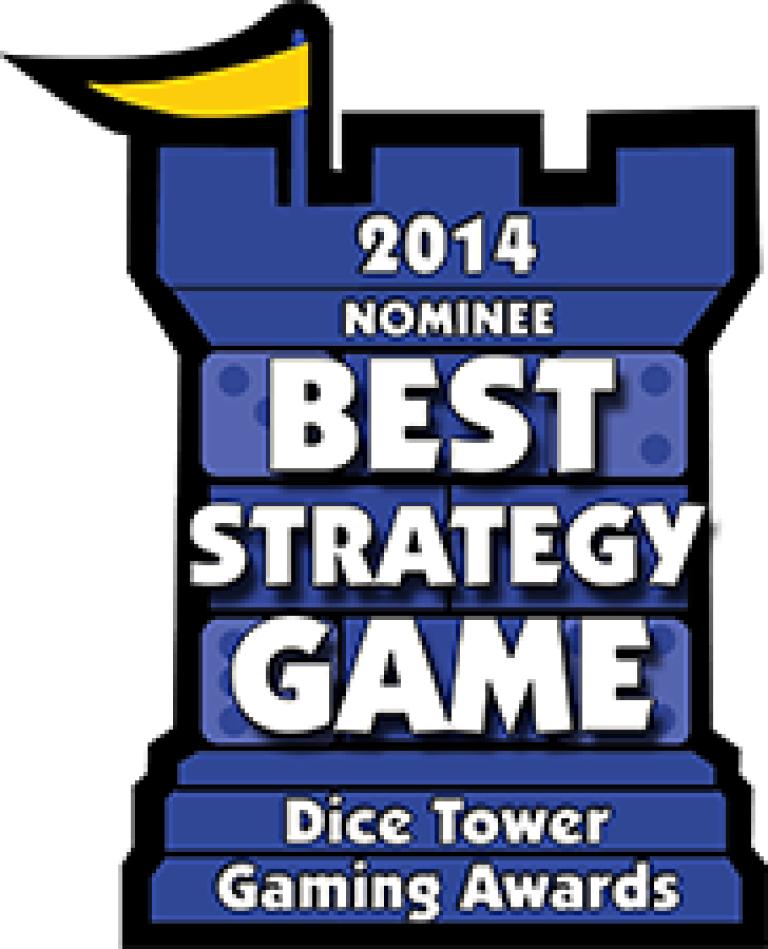
Best Two-Player Game
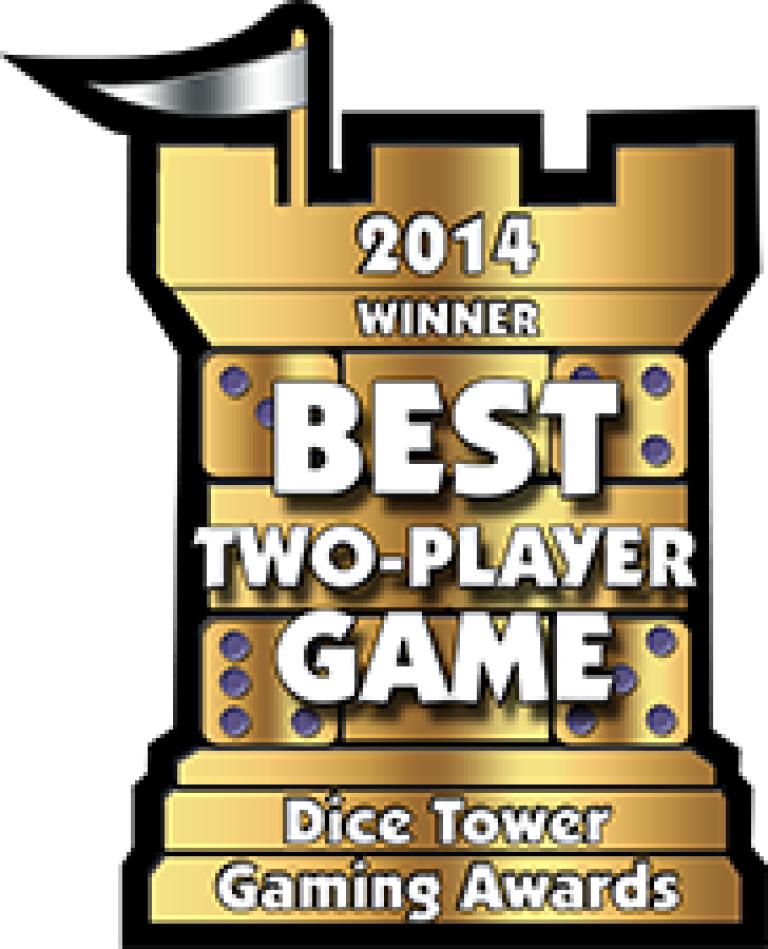
Star Realms is a spaceship combat deck-building game by Magic Hall of Famers Darwin Kastle (The Battle for Hill 218) and Rob Dougherty (Ascension Co-designer).
Star Realms is a fast paced deck-building card game of outer space combat. It combines the fun of a deck-building game with the interactivity of Trading Card Game style combat. As you play, you make use of Trade to acquire new Ships and Bases from the cards being turned face up in the Trade Row from the Trade Deck. You use the Ships and Bases you acquire to either generate more Trade or to generate Combat to attack your opponent and their bases. When you reduce your opponent’s score (called Authority) to zero, you win!
Multiple decks of Star Realms and/or Star Realms: Colony Wars, one for every two people, allows up to six players to play a variety of scenarios. Also, in the newest version, there are new ways to play that allow up to 6 players with modes like Boss, Hunter, and Free for All. You can also add Star Realms Colony Wars to the deck to make it 4 players. This is the first game of the Star Realms series.
Factions
Each of the cards in the 80 card Trade Deck is a Ship or a Base belonging to one of four factions: The Trade Federation, The Blobs, The Star Empire or The Machine Cult.
Trade Federation
In the far future, the more traditional governing bodies of the human race have been replaced with corporate leadership. The earth and its surrounding colonies are ruled by a group of corporations called the Trade Federation. The Federation’s policies are focused around trade and growth, but especially in profit and prosperity for those at the top of the corporate ladder. While they prefer to deal with other star realms using trade and diplomacy, they have a large defense branch dedicated to protecting the Federation’s trade and other interests.
The Blobs
These mysterious creatures are the first alien life forms encountered by the human race. Most of the initial encounters consisted of human colonies being completely obliterated. On the few occasions that a Blob ship has been recovered somewhat intact, the only biological remains found inside have consisted of a gelatinous mass, thus leading to the moniker, “The Blobs”. While for several years all encounters between humanity and the Blobs have been extremely violent, there is currently some limited trade between various Blob factions and some of the more daring human traders.The Blobs are best at generating massive amounts of Combat and at removing undesirable cards from the Trade Row.
Star Empire
The Star Empire consists primarily of former colonies of the Trade Federation. These colonies were on the outer edges of the Federation. Not only did they feel used by the corporations, but they felt the Federation failed to give them adequate protection from the Blobs. As a result, one ambitious colonial governor was able to unite several colonies into an independent empire under his control, one with a strong military, both for warding off the Blobs and for discouraging the Federation from trying to reclaim their lost colonies. The Star Empire is a combat oriented faction that draws lots of cards and makes the opponent discard cards.
Machine Cult
A cluster of industrial mining worlds were completely cut off from the Trade Federation by the Blobs. With the threat of annihilation by the Blobs always looming and no contact with the rest of human space, these worlds were forced to take drastic measures. Soon a cult of technology arose, focused on using advanced technology, robotics and computerization to create strong defenses and a powerful military that belied their relatively small population. Since their leaders believed their salvation lay in technology, technology soon became their god and their religion. The Machine Cult gains most of its power from being able to remove undesirable cards from your deck and from having a large number of Bases designed to defend your Authority from attack.
Playing Star Realms
​When you play Star Realms, you will be able to acquire and use Ships and Bases of any and all of the four factions. Many cards have powerful Ally abilities that reward you for using Ships and Bases of the same faction together, however.
As you acquire cards using Trade, you put them into your discard pile, to be later shuffled into your personal deck. When you draw Ships, you do what they say and they get placed into your discard pile at the end of your turn. When you draw a Base, you play it face up in front of you and may use its abilities once every turn. In addition to Combat being the way you reduce your opponent’s Authority to zero and win the game, it’s also useful for destroying your opponent’s Bases. Some Bases are designated as Outposts. Your opponent’s Outposts must be destroyed before you can use Combat to attack your opponent’s Authority directly.
Star Realms is easy to learn, especially if you’re familiar with deck-building games, but it’s a game that takes time to master. Each time you play, the game is filled with various strategic decision points. Should I take the best card for me or the best card for my opponent? Should I focus on taking cards of a particular faction or on taking the best card available? Should I be focusing on acquiring more Trade or more Combat? Should I attack my opponent’s Base or their Authority? These are just some of the many choices you’ll be faced with. New players needn’t agonize over these choices just to play, but as they become more advanced players, they will find this depth of strategy leads to great replayability.
Star Realms is a fast paced deck-building card game of outer space combat. It combines the fun of a deck-building game with the interactivity of Trading Card Game style combat. As you play, you make use of Trade to acquire new Ships and Bases from the cards being turned face up in the Trade Row from the Trade Deck. You use the Ships and Bases you acquire to either generate more Trade or to generate Combat to attack your opponent and their bases. When you reduce your opponent’s score (called Authority) to zero, you win!
Multiple decks of Star Realms and/or Star Realms: Colony Wars, one for every two people, allows up to six players to play a variety of scenarios. Also, in the newest version, there are new ways to play that allow up to 6 players with modes like Boss, Hunter, and Free for All. You can also add Star Realms Colony Wars to the deck to make it 4 players. This is the first game of the Star Realms series.
Factions
Each of the cards in the 80 card Trade Deck is a Ship or a Base belonging to one of four factions: The Trade Federation, The Blobs, The Star Empire or The Machine Cult.
Trade Federation
In the far future, the more traditional governing bodies of the human race have been replaced with corporate leadership. The earth and its surrounding colonies are ruled by a group of corporations called the Trade Federation. The Federation’s policies are focused around trade and growth, but especially in profit and prosperity for those at the top of the corporate ladder. While they prefer to deal with other star realms using trade and diplomacy, they have a large defense branch dedicated to protecting the Federation’s trade and other interests.
The Blobs
These mysterious creatures are the first alien life forms encountered by the human race. Most of the initial encounters consisted of human colonies being completely obliterated. On the few occasions that a Blob ship has been recovered somewhat intact, the only biological remains found inside have consisted of a gelatinous mass, thus leading to the moniker, “The Blobs”. While for several years all encounters between humanity and the Blobs have been extremely violent, there is currently some limited trade between various Blob factions and some of the more daring human traders.The Blobs are best at generating massive amounts of Combat and at removing undesirable cards from the Trade Row.
Star Empire
The Star Empire consists primarily of former colonies of the Trade Federation. These colonies were on the outer edges of the Federation. Not only did they feel used by the corporations, but they felt the Federation failed to give them adequate protection from the Blobs. As a result, one ambitious colonial governor was able to unite several colonies into an independent empire under his control, one with a strong military, both for warding off the Blobs and for discouraging the Federation from trying to reclaim their lost colonies. The Star Empire is a combat oriented faction that draws lots of cards and makes the opponent discard cards.
Machine Cult
A cluster of industrial mining worlds were completely cut off from the Trade Federation by the Blobs. With the threat of annihilation by the Blobs always looming and no contact with the rest of human space, these worlds were forced to take drastic measures. Soon a cult of technology arose, focused on using advanced technology, robotics and computerization to create strong defenses and a powerful military that belied their relatively small population. Since their leaders believed their salvation lay in technology, technology soon became their god and their religion. The Machine Cult gains most of its power from being able to remove undesirable cards from your deck and from having a large number of Bases designed to defend your Authority from attack.
Playing Star Realms
​When you play Star Realms, you will be able to acquire and use Ships and Bases of any and all of the four factions. Many cards have powerful Ally abilities that reward you for using Ships and Bases of the same faction together, however.
As you acquire cards using Trade, you put them into your discard pile, to be later shuffled into your personal deck. When you draw Ships, you do what they say and they get placed into your discard pile at the end of your turn. When you draw a Base, you play it face up in front of you and may use its abilities once every turn. In addition to Combat being the way you reduce your opponent’s Authority to zero and win the game, it’s also useful for destroying your opponent’s Bases. Some Bases are designated as Outposts. Your opponent’s Outposts must be destroyed before you can use Combat to attack your opponent’s Authority directly.
Star Realms is easy to learn, especially if you’re familiar with deck-building games, but it’s a game that takes time to master. Each time you play, the game is filled with various strategic decision points. Should I take the best card for me or the best card for my opponent? Should I focus on taking cards of a particular faction or on taking the best card available? Should I be focusing on acquiring more Trade or more Combat? Should I attack my opponent’s Base or their Authority? These are just some of the many choices you’ll be faced with. New players needn’t agonize over these choices just to play, but as they become more advanced players, they will find this depth of strategy leads to great replayability.
Year Published:
2014
Designers:
Robert Dougherty
Publishers:
Wise Wizard Games

Most Innovative Game

Tragedy Looper is a scenario-based deduction game for two to four players: one mastermind and one to three protagonists. The game consists of four location boards and a number of character cards. Each scenario features a number of characters, hidden roles for these characters (serial killer, conspiracy theorist, friend), and some pre-set tragedies (murder, suicide).
Each "day" (turn), players and the mastermind play three face-down cards onto the characters, then reveal them to move the characters around or affect their paranoia or goodwill stats. At the end of each day (turn), if the scenario has a tragedy set for that day, it happens if the conditions are met, i.e., certain characters have certain stats or are in a certain location together (or not together) with others. As tragedies happen, players loop back in time, restarting the scenario from the beginning and trying to deduce who the culprit was and why the tragedy occurred.
The players win if they manage to maintain status quo — that is, if no tragedies occur to the key individuals — for a set number of days, within a set number of loops. If not, the mastermind wins.
Tragedy Looper was originally released in Japan as 惨劇RoopeR in 2011; the first english version of the game was released in 2014.
Each "day" (turn), players and the mastermind play three face-down cards onto the characters, then reveal them to move the characters around or affect their paranoia or goodwill stats. At the end of each day (turn), if the scenario has a tragedy set for that day, it happens if the conditions are met, i.e., certain characters have certain stats or are in a certain location together (or not together) with others. As tragedies happen, players loop back in time, restarting the scenario from the beginning and trying to deduce who the culprit was and why the tragedy occurred.
The players win if they manage to maintain status quo — that is, if no tragedies occur to the key individuals — for a set number of days, within a set number of loops. If not, the mastermind wins.
Tragedy Looper was originally released in Japan as 惨劇RoopeR in 2011; the first english version of the game was released in 2014.
Year Published:
2011
Designers:
BakaFire
Publishers:
BakaFire Party

